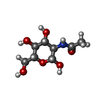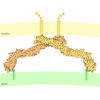+ Open data
Open data
- Basic information
Basic information
| Entry | Database: PDB / ID: 8ywa | |||||||||||||||||||||||||||||||||||||||||||||
|---|---|---|---|---|---|---|---|---|---|---|---|---|---|---|---|---|---|---|---|---|---|---|---|---|---|---|---|---|---|---|---|---|---|---|---|---|---|---|---|---|---|---|---|---|---|---|
| Title | The structure of IgE receptor binding to IgE | |||||||||||||||||||||||||||||||||||||||||||||
 Components Components |
| |||||||||||||||||||||||||||||||||||||||||||||
 Keywords Keywords | MEMBRANE PROTEIN/IMMUNE SYSTEM / immunology / Ige receptor / allergy / MEMBRANE PROTEIN-IMMUNE SYSTEM complex | |||||||||||||||||||||||||||||||||||||||||||||
| Function / homology |  Function and homology information Function and homology informationIgE receptor activity / Fc-epsilon receptor I complex / Fc receptor mediated stimulatory signaling pathway / T cell differentiation involved in immune response / high-affinity IgE receptor activity / negative regulation of mast cell apoptotic process / type I hypersensitivity / mast cell apoptotic process / Fc-gamma receptor III complex / eosinophil degranulation ...IgE receptor activity / Fc-epsilon receptor I complex / Fc receptor mediated stimulatory signaling pathway / T cell differentiation involved in immune response / high-affinity IgE receptor activity / negative regulation of mast cell apoptotic process / type I hypersensitivity / mast cell apoptotic process / Fc-gamma receptor III complex / eosinophil degranulation / serotonin secretion by platelet / positive regulation of mast cell cytokine production / neutrophil activation involved in immune response / positive regulation of mast cell degranulation / Fc-gamma receptor signaling pathway / positive regulation of type III hypersensitivity / regulation of platelet activation / Platelet Adhesion to exposed collagen / positive regulation of type IIa hypersensitivity / IgE binding / positive regulation of protein localization to cell surface / positive regulation of type I hypersensitivity / interleukin-3-mediated signaling pathway / Fc epsilon receptor (FCERI) signaling / type 2 immune response / IgG binding / phagocytosis, engulfment / mast cell degranulation / Dectin-2 family / positive regulation of interleukin-4 production / antigen processing and presentation of exogenous peptide antigen via MHC class I / Fc-epsilon receptor signaling pathway / immunoglobulin mediated immune response / tertiary granule membrane / positive regulation of interleukin-10 production / cellular response to low-density lipoprotein particle stimulus / ficolin-1-rich granule membrane / Role of LAT2/NTAL/LAB on calcium mobilization / GPVI-mediated activation cascade / neutrophil chemotaxis / FCERI mediated Ca+2 mobilization / positive regulation of phagocytosis / osteoclast differentiation / integrin-mediated signaling pathway / protein localization to plasma membrane / Cell surface interactions at the vascular wall / FCERI mediated MAPK activation / FCERI mediated NF-kB activation / antigen processing and presentation of exogenous peptide antigen via MHC class II / receptor internalization / positive regulation of interleukin-6 production / positive regulation of tumor necrosis factor production / cell surface receptor signaling pathway / defense response to bacterium / immune response / innate immune response / external side of plasma membrane / Neutrophil degranulation / cell surface / protein homodimerization activity / identical protein binding / plasma membrane Similarity search - Function | |||||||||||||||||||||||||||||||||||||||||||||
| Biological species |  Homo sapiens (human) Homo sapiens (human) | |||||||||||||||||||||||||||||||||||||||||||||
| Method | ELECTRON MICROSCOPY / single particle reconstruction / cryo EM / Resolution: 3.14 Å | |||||||||||||||||||||||||||||||||||||||||||||
 Authors Authors | Chen, M.Y. / Su, Q. / Shi, Y.G. | |||||||||||||||||||||||||||||||||||||||||||||
| Funding support |  China, 2items China, 2items
| |||||||||||||||||||||||||||||||||||||||||||||
 Citation Citation |  Journal: Nature / Year: 2025 Journal: Nature / Year: 2025Title: Molecular mechanism of IgE-mediated FcεRI activation. Authors: Mengying Chen / Qiang Su / Yigong Shi /  Abstract: Allergic diseases affect more than a quarter of individuals in industrialized countries, and are a major public health concern. The high-affinity Fc receptor for immunoglobulin E (FcεRI), which is ...Allergic diseases affect more than a quarter of individuals in industrialized countries, and are a major public health concern. The high-affinity Fc receptor for immunoglobulin E (FcεRI), which is mainly present on mast cells and basophils, has a crucial role in allergic diseases. Monomeric immunoglobulin E (IgE) binding to FcεRI regulates mast cell survival, differentiation and maturation. However, the underlying molecular mechanism remains unclear. Here we demonstrate that prior to IgE binding, FcεRI exists mostly as a homodimer on human mast cell membranes. The structure of human FcεRI confirms the dimeric organization, with each promoter comprising one α subunit, one β subunit and two γ subunits. The transmembrane helices of the α subunits form a layered arrangement with those of the γ and β subunits. The dimeric interface is mediated by a four-helix bundle of the α and γ subunits at the intracellular juxtamembrane region. Cholesterol-like molecules embedded within the transmembrane domain may stabilize the dimeric assembly. Upon IgE binding, the dimeric FcεRI dissociates into two protomers, each of which binds to an IgE molecule. This process elicits transcriptional activation of Egr1, Egr3 and Ccl2 in rat basophils, which can be attenuated by inhibiting the FcεRI dimer-to-monomer transition. Collectively, our study reveals the mechanism of antigen-independent, IgE-mediated FcεRI activation. | |||||||||||||||||||||||||||||||||||||||||||||
| History |
|
- Structure visualization
Structure visualization
| Structure viewer | Molecule:  Molmil Molmil Jmol/JSmol Jmol/JSmol |
|---|
- Downloads & links
Downloads & links
- Download
Download
| PDBx/mmCIF format |  8ywa.cif.gz 8ywa.cif.gz | 403.1 KB | Display |  PDBx/mmCIF format PDBx/mmCIF format |
|---|---|---|---|---|
| PDB format |  pdb8ywa.ent.gz pdb8ywa.ent.gz | 313 KB | Display |  PDB format PDB format |
| PDBx/mmJSON format |  8ywa.json.gz 8ywa.json.gz | Tree view |  PDBx/mmJSON format PDBx/mmJSON format | |
| Others |  Other downloads Other downloads |
-Validation report
| Summary document |  8ywa_validation.pdf.gz 8ywa_validation.pdf.gz | 638 KB | Display |  wwPDB validaton report wwPDB validaton report |
|---|---|---|---|---|
| Full document |  8ywa_full_validation.pdf.gz 8ywa_full_validation.pdf.gz | 659.3 KB | Display | |
| Data in XML |  8ywa_validation.xml.gz 8ywa_validation.xml.gz | 29 KB | Display | |
| Data in CIF |  8ywa_validation.cif.gz 8ywa_validation.cif.gz | 45.8 KB | Display | |
| Arichive directory |  https://data.pdbj.org/pub/pdb/validation_reports/yw/8ywa https://data.pdbj.org/pub/pdb/validation_reports/yw/8ywa ftp://data.pdbj.org/pub/pdb/validation_reports/yw/8ywa ftp://data.pdbj.org/pub/pdb/validation_reports/yw/8ywa | HTTPS FTP |
-Related structure data
| Related structure data |  39627MC  8yvuC M: map data used to model this data C: citing same article ( |
|---|---|
| Similar structure data | Similarity search - Function & homology  F&H Search F&H Search |
- Links
Links
- Assembly
Assembly
| Deposited unit | 
|
|---|---|
| 1 |
|
- Components
Components
-High affinity immunoglobulin epsilon receptor subunit ... , 3 types, 4 molecules ABDC
| #3: Protein | Mass: 30892.074 Da / Num. of mol.: 1 Source method: isolated from a genetically manipulated source Source: (gene. exp.)  Homo sapiens (human) / Gene: FCER1A, FCE1A / Production host: Homo sapiens (human) / Gene: FCER1A, FCE1A / Production host:  Homo sapiens (human) / References: UniProt: P12319 Homo sapiens (human) / References: UniProt: P12319 |
|---|---|
| #4: Protein | Mass: 30289.541 Da / Num. of mol.: 1 Source method: isolated from a genetically manipulated source Source: (gene. exp.)  Homo sapiens (human) / Gene: MS4A2, APY, FCER1B, IGER / Production host: Homo sapiens (human) / Gene: MS4A2, APY, FCER1B, IGER / Production host:  Homo sapiens (human) / References: UniProt: Q01362 Homo sapiens (human) / References: UniProt: Q01362 |
| #5: Protein | Mass: 9676.426 Da / Num. of mol.: 2 Source method: isolated from a genetically manipulated source Source: (gene. exp.)  Homo sapiens (human) / Gene: FCER1G / Production host: Homo sapiens (human) / Gene: FCER1G / Production host:  Homo sapiens (human) / References: UniProt: P30273 Homo sapiens (human) / References: UniProt: P30273 |
-Antibody , 2 types, 4 molecules HXhx
| #1: Antibody | Mass: 63525.254 Da / Num. of mol.: 2 Source method: isolated from a genetically manipulated source Source: (gene. exp.)  Homo sapiens (human) / Production host: Homo sapiens (human) / Production host:  Homo sapiens (human) Homo sapiens (human)#2: Antibody | Mass: 27441.352 Da / Num. of mol.: 2 Source method: isolated from a genetically manipulated source Source: (gene. exp.)  Homo sapiens (human) / Production host: Homo sapiens (human) / Production host:  Homo sapiens (human) Homo sapiens (human) |
|---|
-Sugars , 1 types, 9 molecules 
| #6: Sugar | ChemComp-NAG / |
|---|
-Details
| Has ligand of interest | Y |
|---|---|
| Has protein modification | Y |
-Experimental details
-Experiment
| Experiment | Method: ELECTRON MICROSCOPY |
|---|---|
| EM experiment | Aggregation state: PARTICLE / 3D reconstruction method: single particle reconstruction |
- Sample preparation
Sample preparation
| Component | Name: The structure of IgE receptor binding to IgE / Type: COMPLEX / Entity ID: #3-#5, #1-#2 / Source: RECOMBINANT |
|---|---|
| Source (natural) | Organism:  Homo sapiens (human) Homo sapiens (human) |
| Source (recombinant) | Organism:  Homo sapiens (human) Homo sapiens (human) |
| Buffer solution | pH: 7.5 |
| Specimen | Embedding applied: NO / Shadowing applied: NO / Staining applied: NO / Vitrification applied: YES |
| Vitrification | Cryogen name: ETHANE |
- Electron microscopy imaging
Electron microscopy imaging
| Experimental equipment |  Model: Titan Krios / Image courtesy: FEI Company |
|---|---|
| Microscopy | Model: FEI TITAN KRIOS |
| Electron gun | Electron source:  FIELD EMISSION GUN / Accelerating voltage: 300 kV / Illumination mode: FLOOD BEAM FIELD EMISSION GUN / Accelerating voltage: 300 kV / Illumination mode: FLOOD BEAM |
| Electron lens | Mode: BRIGHT FIELD / Nominal defocus max: -2000 nm / Nominal defocus min: -1200 nm |
| Image recording | Electron dose: 50 e/Å2 / Film or detector model: GATAN K3 BIOCONTINUUM (6k x 4k) |
- Processing
Processing
| EM software | Name: PHENIX / Category: model refinement | ||||||||||||||||||||||||
|---|---|---|---|---|---|---|---|---|---|---|---|---|---|---|---|---|---|---|---|---|---|---|---|---|---|
| CTF correction | Type: NONE | ||||||||||||||||||||||||
| 3D reconstruction | Resolution: 3.14 Å / Resolution method: FSC 0.143 CUT-OFF / Num. of particles: 920752 / Symmetry type: POINT | ||||||||||||||||||||||||
| Refine LS restraints |
|
 Movie
Movie Controller
Controller




 PDBj
PDBj
















